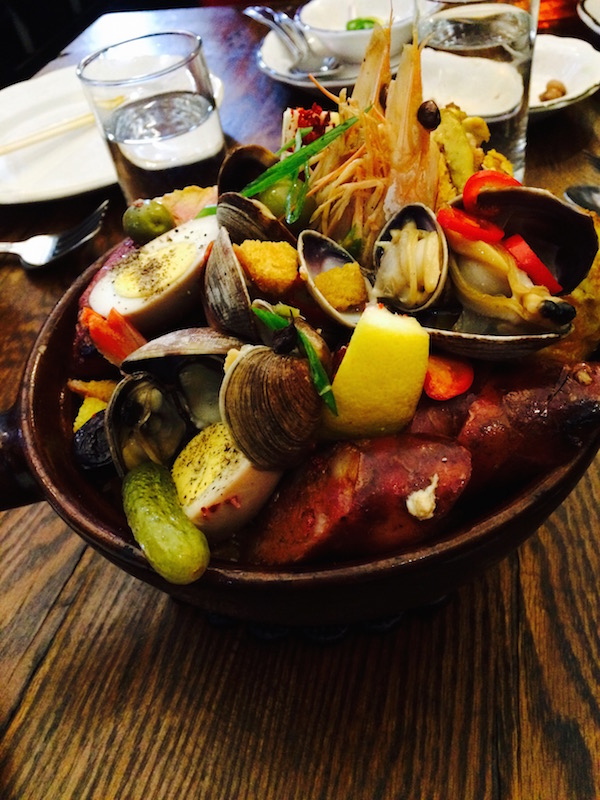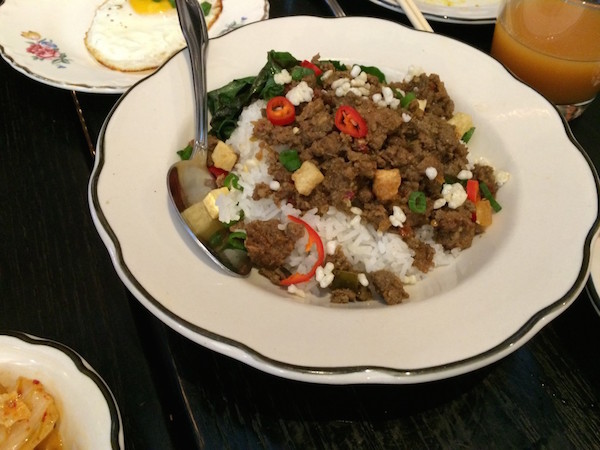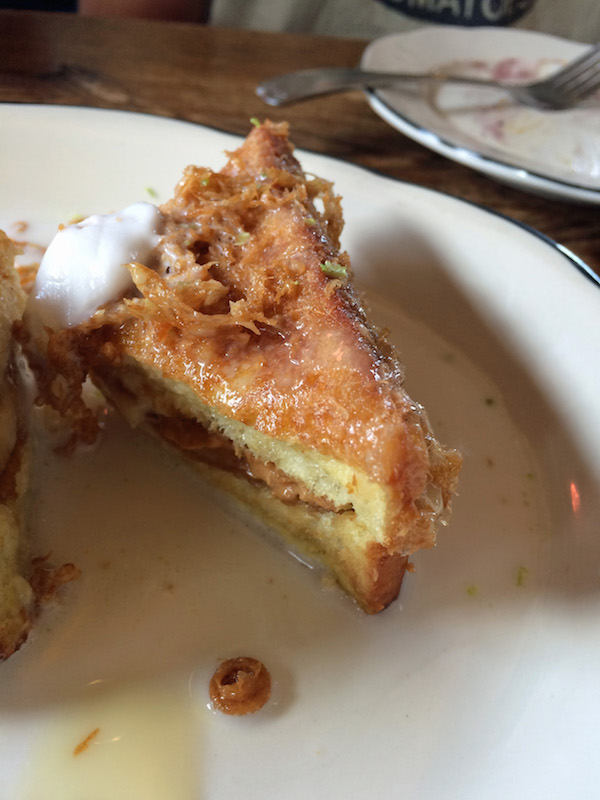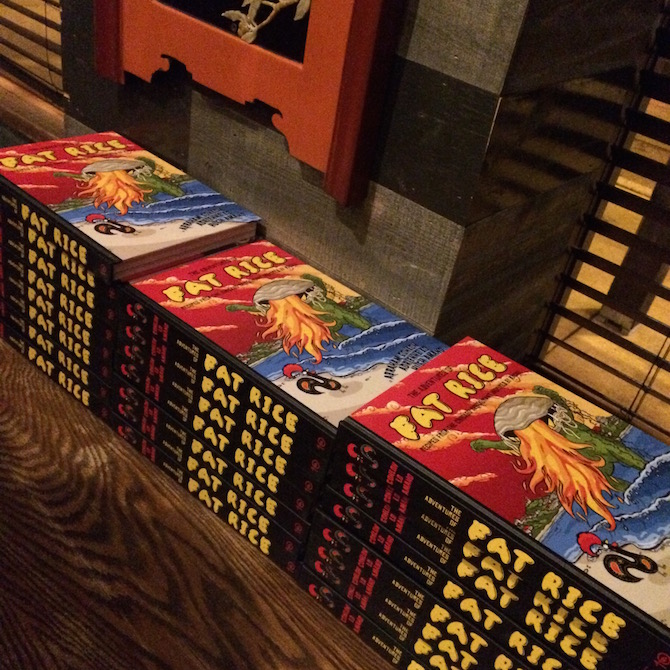Arroz gordo, or fat rice, is one of the most popular dishes in Macau. With Portuguese and Chinese influences, the dish is comprised of rice, of course, but it’s much more than just that. It’s an amalgamation of poultry, seafood, sausage, olives, raisins, and tea eggs. There aren’t many Macanese restaurants in the United States, but one in Chicago has quickly gained national recognition. Its name: Fat Rice.
I met the owners, Abe Conlon and Adrienne Lo, several Lunar New Years ago. Abe is Portuguese-American and originally from Lowell, Massachusetts, a town with a large Southeast Asian population. Adrienne grew up in a Chinese-American family in Chicago. It was only natural, then, that they founded restaurant that brought together tastes from Portugal and Asia’s southern half. Macau, a former Portuguese colony off the coast of Southern China, fit the culinary bill just perfectly. Hugh Amano, who was instrumental in opening the restaurant, joins them as a co-author of the book associated with the eatery.
Although I live twenty miles outside Chicago, Fat Rice felt like my neighborhood restaurant from the first time I visited. Abe recognized me from Twitter, remembering a post I’d written about my attempts at baking Thanksgiving pies a couple months earlier. With each subsequent visit, Abe, Adrienne, and I would talk about Hong Kong, Macau, and books. I had lived in Hong Kong two decades earlier, during which I’d made a couple of daytrips to Macau. About a year after we met, with books on my mind due to having one coming out, I learned that they had one in the works, too, and promised myself I’d be at their book launch whenever it took place. I’m not much of a cook, but figured I’d enjoy the stunning pictures their photographer Dan Goldberg took in Macau on one of Abe and Adrienne’s trips there.
Fast forward two years or so and I got my chance. The Adventures of Fat Rice: Recipes from the Chicago Restaurant Inspired by Macau (Ten Speed Press, 2016) recently came out and is selling well on Amazon. Late last month, I got to attend their book release party, held, naturally, at the restaurant.
The book is beautiful. Part cookbook, part coffee table book, and part graphic novel, it is a feast for the eyes. The cookbook part showcases recipes of their popular dishes, including arroz gordo, complete with a photo spread and a fun cross-section drawing of a fat rice clay pot by Sarah Becan, who illustrated the book and all of the restaurant’s signage (an example of which can be seen in the book’s cover artwork). As the authors explain, fat rice in Macau is traditionally served in large platters for special events like weddings and birthday parties. The restaurant’s portions are smaller, feeding up to four people, and the recipe in their book reflects that.

Another popular dish at Fat Rice is minchi, or Macanese minced meat hash. It’s a simple dish of ground meat — pork and beef are popular choices — with three types of soy sauce and other spices and seasonings. I learned from the book that Macanese families have different ways of serving minchi. Some like it over a bed of white rice, others over noodles, and still others in a sandwich. The restaurant prepares it over rice with a fried egg on top and combined with steamed green vegetables. Looking over the complexity of the recipes in the book, it appears that minchi is one of the easier ones to prepare.

Also popular at the restaurant and featured in the book is a dish called Hong Kong-style French Toast. Despite its name’s link to another South China city with a European colonial part, the dish is popular in Macau and is one of Fat Rice’s most treasured brunch items. I was happy to see a recipe for it in the cookbook, since I enjoyed eating Hong Kong French Toast at teatime when I lived in the eponymous metropolis. But it never tasted as delicious or fresh in the Hong Kong venues I frequented as it does in Fat Rice’s variation, where it becomes basically a peanut butter and banana sandwich gently fried in a batter of fine egg threads. The Fat Rice version is topped with coconut cream, papaya jam, young coconut shavings, toasted cashews, lime zest, and fresh mint leaves, or any combination of these. (The cookbook includes recipes for the coconut cream and papaya jam toppings.)

In the book, the Hong Kong French Toast recipe isn’t accompanied by a photo, but rather by a Sarah Becan comic that offers a step-by-step guide to the dish’s preparation. Illustrations such as these give the book a graphic novel quality not found in many cookbooks. I spoke with Becan about her work and learned that it’s not easy for women to work in the genre of comics. Becan told me it’s still a male-dominated field and there is quite often hostility on social media toward women who draw them. She also spoke of her love of Asian food, her experiences traveling on the other side of the Pacific, and the enjoyment she got, while working on the cookbook, sampling many of the recipes it contains. One of her favorite Macanese dishes is a crispy crepe holding together seven pot stickers. For this dish, readers get both a full-page photo and a nicely complementary illustration of hers.
Dan Goldberg’s photos are just as striking as Becan’s drawings. Whether they are candid shots of eateries in Macau or of Macanese street scenes, or staged photos of prepared dishes from the restaurant or of specific ingredients, each photo is beautifully presented and makes me wonder why I haven’t been back to Macau in over twenty years. I also not regret not paying closer attention to Macanese food during my long ago daytrips. It’s ironic that I’ve learned more about this cuisine in Chicago than I during my five years living in Hong Kong. I’m delighted that everyone can now get a long distance taste of Macau via this remarkable restaurant and its cookbook. My new promise to myself is to visit Macau on my next trip to Hong Kong. Thanks to my friends at Fat Rice and their cookbook, I’ll know what to order.


